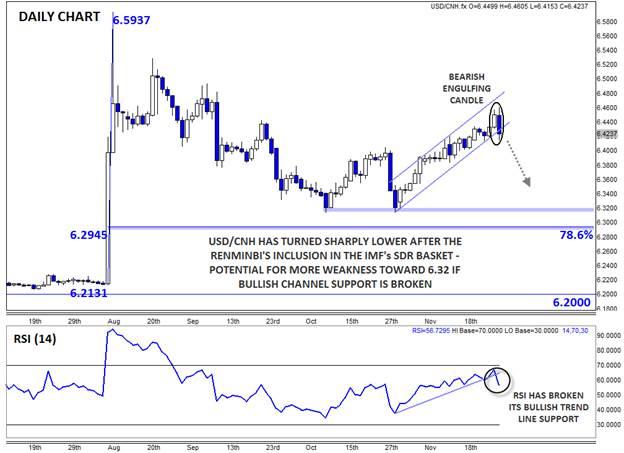![]()
In a week full of market-moving three-letter acronyms (ECB, NFP RBA, PMI, and GDP from Australia and Canada), many traders may not be intimately familiar with the three-letter acronym that’s grabbing all the headlines today.
The International Monetary Fund (IMF) maintains a stockpile of foreign exchange reserve assets called Special Drawing Rights (SDR). In essence, SDRs represent a basket of other widely-used currencies that was created back in the late ‘60s to supplement a shortfall of US dollars and gold. Every five years, the IMF reviews the currencies and weights within the SDR basket to ensure that it still reflects the importance and usage of global currencies.
As it happens, the IMF completed its semi-decadal review earlier today, and as widely expected, opted to include the Chinese renminbi in its SDR basket effective October 1, 2016. Though it was generally expected, the IMF’s inclusion of the RMB within the SDR basket represents a major triumph for Chinese authorities, who have been liberalizing trade in the renminbi for years in an attempt to increase the international clout of the currency.
The previous and new SDR basket weights can be seen below:
· 2011-2016: US dollar (41.9%), euro (37.4%), pound (11.3%), yen (9.4%)
· Starting October 2016: US dollar (41.7%), euro (30.9%), Chinese yuan (10.9%), yen (8.3%), pound (8.1%)
As you can see, the biggest loser from this change was the euro, while the yen and the pound also saw their significance decrease. The dollar’s weight will be essentially unchanged after this update goes into effect.
By now, many readers are no doubt wondering what this means for markets. First of all, it’s worth noting that although many analysts refer to SDRs as “reserves,” this shift does not mean that China’s currency has become a “reserve currency” in the traditional sense of the word. The dollar is and will be the world’s reserve currency for the foreseeable future.
That said, there are nearly $300B in SDRs in circulation that will have to be adjusted for the new distribution over the next ten months. A portion of this massive stockpile of reserves will have to be rebalanced away into Chinese yuan and away from (primarily) the euro. This colossal wave of capital flowing into China’s currency should provide support the CNY and CNH while providing traders with yet another reason to sell the beleaguered euro.
Technical view: USD/CNH
Looking at the recently-liberalized USD/CNH exchange rate shows that bears are having a strong day. The pair is currently carving out a big Bearish Engulfing Candle* on the daily chart, signaling a strong shift from buying to selling pressure. Meanwhile, the pair is on the verge of breaking down from its 1-month bullish channel, a move that the RSI indicator has already foreshadowed.
The full brunt of the IMF’s decision will play out over the next ten months and many other factors will no doubt influence the yuan’s value over that period, but in the short-term, a confirmed break below the bullish channel could open the door for a deeper retracement in USD/CNH toward its recent lows its recent lows in the 6.32 zone.
*A Bearish Engulfing candle is formed when the candle breaks above the high of the previous time period before sellers step in and push rates down to close below the low of the previous time period. It indicates that the sellers have wrested control of the market from the buyers.

This research is for informational purposes and should not be construed as personal advice. Trading any financial market involves risk. Trading on leverage involves risk of losses greater than deposits.
Recommended Content
Editors’ Picks

AUD/USD: The hunt for 0.7000 kicks in
AUD/USD finally cleared the key 0.6800 barrier, up for the fourth session in a row on the back of the persistent downward momentum in the Greenback in the wake of the Fed’s rate cut.

EUR/USD maintains its constructive tone and targets 1.1200
EUR/USD managed to add to Wednesday’s gains and climbed to the area of weekly tops around 1.1180 following further weakness in the US Dollar as investors continued to factor in the likelihood of extra rate cuts in the next few months.

Gold maintains the upward pressure near $2,600
Following a pullback in the early American session, Gold regains its traction and trades decisively higher on the day at around $2,580. The 10-year US Treasury bond yield retreats toward 3.7%, supporting XAU/USD in the Fed aftermath.

XRP eyes gains as Ripple gears up for stablecoin launch, Grayscale XRP Trust notes rising NAV
Ripple (XRP) gained 2.3% since the start of the week. The altcoin’s gains are likely powered by key market movers that include Ripple USD (RUSD) stablecoin, Grayscale XRP Trust performance and the demand for the altcoin among institutional investors.

BoE expected to keep interest rate unchanged at 5% as price pressures persist
After a close call in August, the Bank of England’s September interest rate decision is keenly awaited for fresh cues on the bank’s future policy action and the pace of its bond sales.

Moneta Markets review 2024: All you need to know
VERIFIED In this review, the FXStreet team provides an independent and thorough analysis based on direct testing and real experiences with Moneta Markets – an excellent broker for novice to intermediate forex traders who want to broaden their knowledge base.